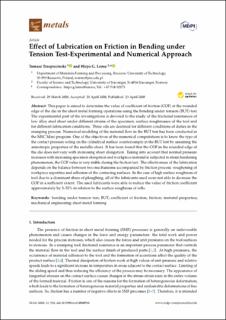| dc.contributor.author | Trzepiecinski, Thomasz | |
| dc.contributor.author | Lemu, Hirpa G. | |
| dc.date.accessioned | 2023-02-08T08:17:25Z | |
| dc.date.available | 2023-02-08T08:17:25Z | |
| dc.date.created | 2020-05-02T09:06:04Z | |
| dc.date.issued | 2020 | |
| dc.identifier.citation | Trzepiecinski, T., & Lemu, H. G. (2020). Effect of lubrication on friction in bending under tension test-experimental and numerical approach. Metals, 10(4), 544. | en_US |
| dc.identifier.issn | 2075-4701 | |
| dc.identifier.uri | https://hdl.handle.net/11250/3049103 | |
| dc.description.abstract | This paper is aimed to determine the value of coefficient of friction (COF) at the rounded edge of the die in the sheet metal forming operations using the bending under tension (BUT) test. The experimental part of the investigations is devoted to the study of the frictional resistances of low alloy steel sheet under different strains of the specimen, surface roughnesses of the tool and for different lubrication conditions. Three oils are destined for different conditions of duties in the stamping process. Numerical modeling of the material flow in the BUT test has been conducted in the MSC.Marc program. One of the objectives of the numerical computations is to know the type of the contact pressure acting on the cylindrical surface countersample in the BUT test by assuming the anisotropic properties of the metallic sheet. It has been found that the COF in the rounded edge of the die does not vary with increasing sheet elongation. Taking into account that normal pressure increases with increasing specimen elongation and workpiece material is subjected to strain hardening phenomenon, the COF value is very stable during the friction test. The effectiveness of the lubrication depends on the balance between two mechanisms accompanied by friction process: roughening of workpiece asperities and adhesion of the contacting surfaces. In the case of high surface roughness of tool due to a dominant share of ploughing, all of the lubricants used were not able to decrease the COF in a sufficient extent. The used lubricants were able to reduce the value of friction coefficient approximately by 3–52% in relation to the surface roughness of rolls. | en_US |
| dc.language.iso | eng | en_US |
| dc.publisher | MDPI | en_US |
| dc.rights | Navngivelse 4.0 Internasjonal | * |
| dc.rights.uri | http://creativecommons.org/licenses/by/4.0/deed.no | * |
| dc.title | Effect of Lubrication on Friction in Bending under Tension Test-Experimental and Numerical Approach | en_US |
| dc.type | Peer reviewed | en_US |
| dc.type | Journal article | en_US |
| dc.description.version | publishedVersion | en_US |
| dc.rights.holder | The authors | en_US |
| dc.subject.nsi | VDP::Teknologi: 500 | en_US |
| dc.source.pagenumber | 544-? | en_US |
| dc.source.volume | 10 | en_US |
| dc.source.journal | Metals | en_US |
| dc.source.issue | 4 | en_US |
| dc.identifier.doi | 10.3390/met10040544 | |
| dc.identifier.cristin | 1809066 | |
| cristin.ispublished | true | |
| cristin.fulltext | original | |
| cristin.qualitycode | 1 | |

